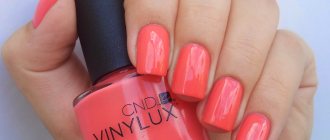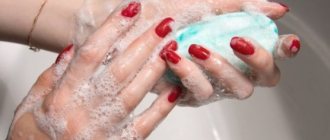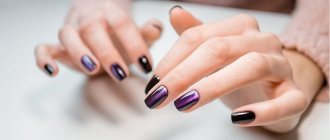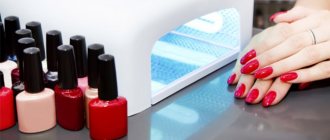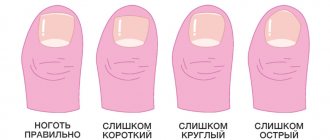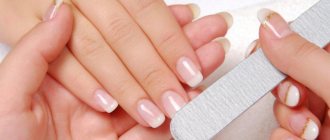Recommendations for children's nail care
Nails begin to grow from infancy, so every mother regularly shortens the length of the nail plates so that the baby does not break them or scratch someone during his activity, cleans them of dirt and removes burrs. Pediatricians recommend this kind of hygienic care for a child’s hands for as long as possible – up to 14–16 years of age.
Important! It is until the age of 14–16 that the nail plate is formed in children, so any impact can lead to its deformation, disruption of structure and fragility; it will take a lot of time to restore the nails.
But at the age of 4-5 years, it is no longer enough for girls to simply cut their nails, and they begin to ask them to paint them, and at the age of 12 they want to extend them or cover them with gel polish. From what point it is permissible to carry out such manipulations is discussed below.
Experts recommend following the following manicure rules for children:
- for children under 6 years of age, trim their nails regularly, carefully push back the cuticles with a special wooden stick and do not cut them under any circumstances;
- limit any manicure procedures (extensions, gel coating) to girls until at least 14 years old, and it is better to wait as long as possible.
Manicure set for children
Basic set for children's hygienic manicure.
For home manicure, the set can be purchased ready-made. As a rule, it includes tools for caring for the nail plate, cuticle, and nail folds. This:
- scissors
- wire cutters
- tweezers
- metal or orange wood cuticle sticks
Children's manicure set.
Separately, you should purchase products for the care of nails and fingers. They must be selected from the children's line:
- antiseptic
- Massage Oil
- cuticle cream or oil
If the girl is older, she is having a nail design done; you should also stock up on supplies for it. Need to buy:
- varnishes, possibly water-based
- acrylic paints
- brushes, sticks, stencils for creating a picture
- stickers for nails
- stones, rhinestones, sparkles
- foil
- other accessories
Accessories for manicure on the theme of the cartoon “Frozen”.
Accessories for manicure on the theme of the cartoon “My Little Ponies”.
Set for children's manicure "Mini Mouse".
At what age are girls allowed to dye them?
Often, mothers cannot resist the little girl’s requests to paint her nails with varnish and apply adult varnish to both themselves and their daughter. At the same time, without suspecting that such decorative coatings contain substances that are dangerous to the child’s body - toluene, dibutyl phthalate, formaldehyde, which can cause irritation or an allergic reaction.
Experts recommend using children's varnishes for coating for at least 12 years, which are considered safe because:
- are water-based and can be easily washed off with warm water and soap, rather than aggressive nail polish removers;
- before applying them, there is no need to specially treat the child’s nail plate, which has not yet been formed;
- There are no harmful substances in the composition.
Also, covering your nails with baby polish helps to cope with the bad habit of biting your nails.
Attention! You can buy a set of children's polishes of different colors with various sparkles, stickers, and turn the manicure procedure into a game.
Older girls are occasionally allowed to use adult varnishes, but their composition should be gentle, and before application, the nails should be coated with a protective medicinal agent.
So children are not allowed to paint their nails with nail polish?
In most studies, risks are labeled as perceived. In addition, in order to feel the negative effect, you need to receive a certain dose of these substances. As long as children, although they love to do this, do not put their fingers with painted nails in their mouths, the danger is minimal. (Parents can monitor this or stop it altogether)
Usually a coated manicure is a game for children, and they don't wear polish for long. A couple of days with multi-colored nails won't hurt anyone. And yet you should not neglect safety measures. Choose children's polishes and make sure that your fingers do not reach towards your mouth.
When is it acceptable to start getting nail extensions?
The nail plate is formed until the age of 14–16, so experts recommend holding off on the extension procedure until this age, since polishing before extension can seriously damage the nail.
Reference. Also, until the age of 16–17, intense hormonal changes occur in a girl’s body, which reduces the duration of wearing extended nails.
Often scandals and quarrels arise between mother and daughter over the issue of nail extensions. In this case, psychologists recommend not to spoil the relationship with the teenager, but to give the girl the opportunity to fulfill her desire. At the same time , several procedures performed by an experienced specialist will not cause irreversible consequences, but:
- the child will satisfy his needs and curiosity;
- the effect of novelty will disappear, and the need for extension will quickly disappear;
- the appearance of the nail platinum after removing extended nails will be an additional argument in favor of refusing to repeat this procedure.
Psychological influence
Everything that parents do is desirable for the child also because it is perceived as an attribute of adulthood; it is connected with the child’s desire to “become big.” By associating the concept of growing up with the use of cosmetics, parents form a vicious attitude in their daughter, which will certainly manifest itself in the future: “external attractiveness to the opposite sex is the main value.” Such a girl runs the risk of growing up not as a self-sufficient person, but as a “doll” aimed at “selling herself at a higher price.”
Another vicious attitude, associated with an excessively early acquaintance with cosmetics, including nail polish, associates the idea of beauty exclusively with the use of cosmetics. It is much more important to form a girl’s idea of the “beauty of health.”
Painting your nails may meet with a negative reaction from kindergarten teachers or school teachers. If the parents come into conflict with the teachers because of this, the teachers’ authority in the girl’s eyes will suffer, but if the parents comply with the demands, their own authority will suffer (“first they allowed it, then they banned it”). The pedagogical effect in both cases will be negative.
If parents still want to teach their daughter to use cosmetics in general and nail polish in particular, it is better to use special cosmetics intended for children. Even this varnish should not be used every day. You need to explain to the girl in advance that she will paint her nails only on special occasions - for example, to go to the theater or to visit.
When is it recommended to start applying gel polish?
The most popular modern decorative coating is considered to be gel polish, since it is quite durable and attracts the attention of others. But with all its advantages, there is one significant disadvantage for children’s nails - before applying it, you need to very carefully prepare the nail plate.
Therefore, all experts recommend starting to use this coating no earlier than 16–17 years of age. After all, by this age:
- in girls, the process of puberty is coming to an end and hormonal levels are stabilizing;
- The nail plate is finally formed - it becomes thicker and stronger.
As arguments for postponing the procedure of covering the nails with gel polish, a mother can tell:
- about the dangers of the substances included in gel polish (formaldehyde has a carcinogenic effect and can accumulate in the body, toluene affects the nervous system, dibutyl phthalate affects hormonal levels, skin and respiratory organs);
- that children’s nails grow faster and the coating will soon have to be removed;
- painting with regular varnish is more justified, because you can change the design several times and the growing nail will not be visible.
Next, you can watch a video that tells you at what age children can apply gel polish:
Mothers of girls need to prepare for questions regarding manicure and try to explain that natural, well-groomed nails look good without extensions and gel polish. It is recommended to teach the girl how to care for her nails - carefully trim them, shape them, do hand baths and massages with various oils if she is not allergic.
Beautiful children's manicure - drawings
Usually, it is not enough for girls who are fashionistas to simply cover their nails with a single-color varnish. They want beautiful and interesting designs on the following topics:
- flowers
- animals
- butterflies
- fruits and sweets
- "girly" symbols, such as bows or hearts
- cartoon characters
- other
Girls also really love various versions of French manicure and lace designs. They ask to decorate their nails with rhinestones, stones, and sparkles.
What is the procedure
Everything is very serious here. Children's manicure requires complete treatment of the nail plate and the fingers themselves with a number of special natural products and aids with the maximum level of protection.
We recommend reading:
Manicure for oval nails - 95 photo examples of the best ideas and most fashionable solutions for the 2019-2020 seasonMedium-length manicure - the best ideas for 2022, features of choosing a style and beautiful nail design ideas (115 photos + video)
- Manicure for round nails: 130 photo ideas, design features and tips on how to create an elegant nail design
Not every nail aesthetics specialist has such an assortment in his arsenal, so warn in advance about who will be doing the manicure.
Shellac for nails. Advantages and disadvantages
A good manicure is an important component of every woman’s image. Sometimes it reflects the girl’s inner world and her perception of reality. When creating a manicure, each of us secretly hopes that it will last a long time on our nails. But as practice shows, any manicure created at home is doomed to a short, even bright, life. Constant contact with water, housework, cooking in the kitchen, playing sports, playing with children are not easy tests. As a result, the varnish...
Discussion
As you can see, the procedure is quite complicated, so if you are not confident in your abilities, do not try to make shellac yourself.
Pros of shellac
Allows you to grow your nails
Shellac is perfect for those with short and long nails. It solves several main problems at once: if your nails are thin and brittle, it strengthens them and makes it possible to grow them. After all, the nail under the coating does not delaminate or crack.
Stays on nails for a long time
Shellac cannot be removed without special products, which means it is not afraid of household chemicals. This gel polish can be worn for up to 3 weeks. Gives a bright glossy shine
Shellac is the only product that gives incredible shine to nails that does not fade over time.
Pleases with the variety of palettes
Today, shellac manufacturers have developed many color options - from classic pink tones to bright, rich shades. The palette is constantly updated with fashionable seasonal colors.
Shellac is harmless
Shellac does not contain dangerous substances such as formaldehyde. This means that pregnant girls can also get a shellac manicure. It will not cause damage to health, since gentle substances are used in its production. The coating can be removed independently
If you do not want to make a correction, and you are tired of wearing shellac on your nails, you can purchase a special liquid and film at the salon, with which the coating can be easily removed. Instructions included.
Not for the sake of rhetoric and not out of fear of competition, many manicurists started talking about the harm that shellac can cause.
High price
Shellac is an expensive procedure, sometimes the cost is equal to standard extensions. In addition, this coating also needs correction, and it is quite expensive. If your nails grow at cosmic speed, then you will need to frequently resort to correction; you cannot do it at home yourself.
Nail diseases
In appearance, the coating seems durable, which is what the manufacturer promises us. However, shellac is subject to temperature conflicts. For example, when we clean with rubber gloves, take a bath or wash dishes, our nail expands under the influence of heat and moisture, then contracts again, taking on its natural shape.
Such deformation of the nail plate can cause microcracks in the coating that are invisible to the eye. Through cracks, dirt and water can get under the shellac layer, and these are excellent conditions for the growth of bacteria. And since shellac is a long-lasting coating, harmful creatures will have enough time to celebrate the housewarming and begin their subversive activities to destroy the health of the nails. The most harmless thing you can end up with is a fungus.
Dangers of wearing long nails in children
When parents ask at what age can nails be extended, they do not always understand the consequences of this procedure. Children do not have as much control over their bodies as adults. They are impulsive and can easily break an artificial nail with a sharp involuntary movement. Asking your child to take care of new nails is pointless. Children cannot fully control themselves. Only by the age of sixteen or seventeen, when the girl has formed, her movements will become smooth and calculating, we can talk about long nails.
A broken nail usually results in a broken nail bed. There may be a wound, blood flow. Of course, no mother wants this for her child. Therefore, it is better for girls not to wear long nails. A millimeter of free edge is ideal, allowing you to wear comfortable and healthy nails.
A little about children's nails
Children's horny plates differ from the structure of adults. They are not that durable. At an early age, the nail does not even completely cover the nail bed. Children's nails are much thinner and more elastic than those of adults. Their flexibility is pronounced due to their high moisture content. The cuticles on children's nails are still very soft. It cannot be pruned before adolescence.
It is believed that the nail becomes more or less strong at the age of 15-16 years. For this reason, their nails are more vulnerable to infection. The situation may also be aggravated by the fact that children do not wash their hands as often. Already on the basis of this information, some parents can make a decision regarding at what age their children can have shellac.
The art of long nails
There are several rules that must be followed when wearing long nails. It involves careful opening of doors and wearing clothes, carefully carrying a bag, and avoiding clenching your palm into a fist. After all, long nails experience a lot of stress in the stress zone. They bend and break. They often pull away or break, leaving a bruise on the nail bed.
If the modeling material reaches length, with the wrong movement it peels off along with part of the keratin of the nail. This lesion cannot be treated; you will have to wait four months before the nail grows completely. Of course, you can use biogel to isolate from the external environment. But the length cannot be preserved.
If we take into account all of the above, then parents themselves will understand how many years it will take them to build up their child’s nails. The girl is quite neat, can she follow the rules of wearing long nails? After weighing all the pros and cons, you can find the optimal solution.
Don't judge mom harshly
Is a manicure really necessary for children of preschool and school age? This is a secondary question. But whether it can be done in principle is the most important thing.
Despite everything, it turns out that it really can be done, and there are special varnishes for children's manicure for this purpose.
Of course, at first glance the phrase itself sounds crazy, but it is true, apparently while we were busy with our own affairs, the nail aesthetics industry has stepped far forward.
Young beauties who want to look even better try to take care of their appearance from an early age.
When it comes to nails and the procedure for bringing them into the proper “adult” appearance, there are some rules to follow.
In addition, even simply cutting the nails can cause harm to the nail plate, since its excessive tenderness is not yet able to adapt to mechanical influences.
If the nail is damaged, then in adult life it will grow uneven and ugly.
Is hardware manicure allowed?
The use of special equipment is strictly prohibited. The principle of its operation is to remove dead cells from the cuticle, and this is very harmful for the child.
Moreover, in the future the cuticle may take on a thickened shape and a completely unesthetic appearance. But this is only the beginning of the problems. For children over 14 years old, special devices have been developed that take into account the characteristics of their age.
Building up
At what age can children get nail extensions? For teenagers, extensions are even more prohibited than gel polish. Mothers know this, so they make concessions to their daughters and agree to gel polish as a safer alternative to extensions. Choose the lesser of two evils.
The best way to grow your child’s nails is to take care of their health, then they will be strong and quickly grow to the desired length. If your nails grow slowly, peel, or break off, consult a doctor. Perhaps the body simply does not have enough vitamins or minerals.
The effect of varnish on the child’s body.
Some parents mistakenly believe that external use of varnish makes it safe. It contains a huge amount of harmful substances that can penetrate the baby’s body through the nail plate. One of these elements is formaldehyde. It can depress the nervous system, reduce immunity, and even in some cases, at maximum permissible concentrations, leads to the development of cancer.
The carcinogenic components toluene and methylbenzene also contain potential dangers. They help to make the coating uniform, without flaws, but can also cause severe coughing and nausea.
Acetate is a solvent that is used by manufacturers to give the varnish a liquid state and a quick drying effect. When exposed to air, hazardous substances begin to evaporate, releasing a caustic gas. It's easy to imagine how dangerous it is to use nail polish at an early age. Acetate vapor can lead to poisoning of a fragile child's body and the appearance of headaches. The same reaction can also occur from camphor, a very poisonous component of decorative coatings.

